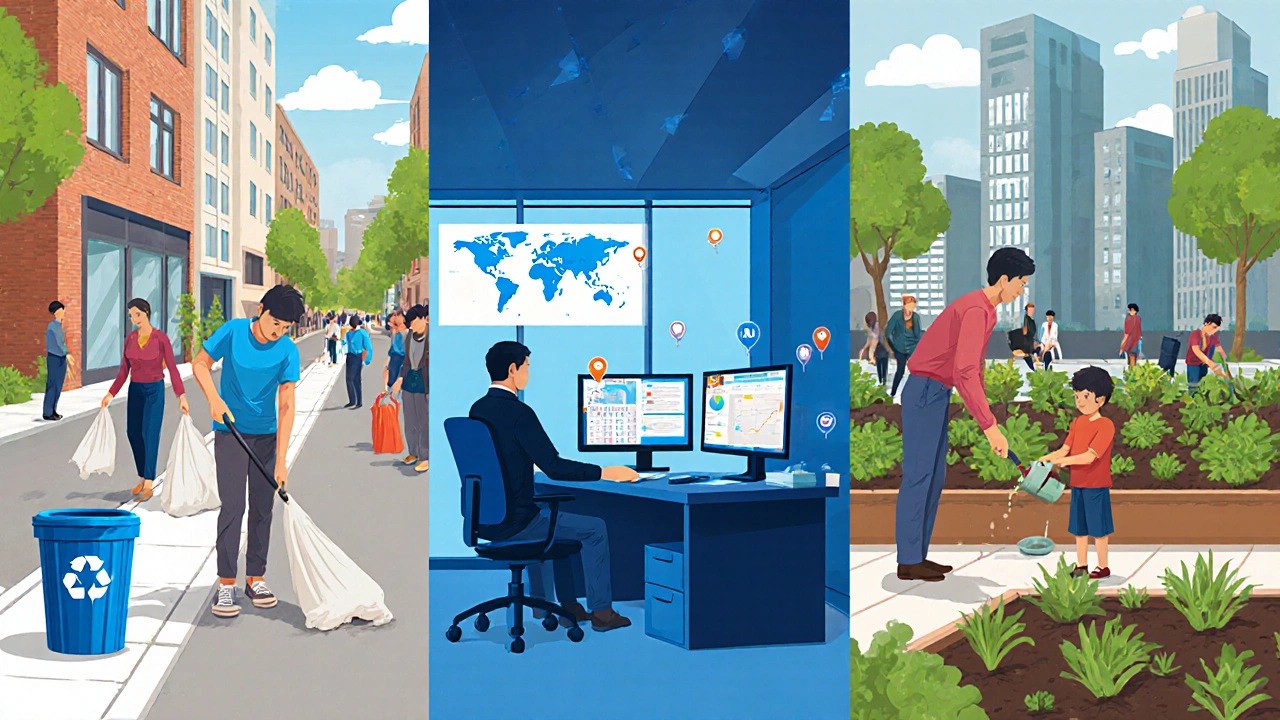What Does an Environmental Group Actually Do? Definition, Types & Impact
 Oct, 22 2025
Oct, 22 2025
Environmental Group Legitimacy Checker
Verify an Environmental Group
Check legitimacy using the 5 key criteria from the article. This tool helps you avoid greenwashing and identify credible organizations.
When you hear the term environmental group is an organization-often a non‑governmental organization (NGO) or grassroots movement-dedicated to protecting natural ecosystems, promoting sustainable practices, and influencing policy to curb environmental damage, you might picture a protest outside a coal plant or a logo with a green leaf. In reality, the world of environmental groups is far broader, ranging from tiny local clean‑up clubs to global advocacy powerhouses. This guide breaks down what an environmental group really means, why they matter, and how you can tell one apart from the rest.
Defining the Core: What Is an Environmental Group?
At its core, an environmental group is any collective-formal or informal-whose primary mission centers on the environment. That mission can involve conserving wildlife, fighting climate change, promoting renewable energy, or simply educating the public about sustainability. While many operate as registered charities or NGOs, dozens function as volunteer clubs, community coalitions, or even online activist networks.
environmental group
Why Do They Exist? The Main Purposes
- Conservation: Protecting habitats, endangered species, and biodiversity hotspots.
- Advocacy: Lobbying governments, corporations, and international bodies for stronger environmental laws.
- Education: Running workshops, school programs, and public campaigns to raise awareness.
- Research & Monitoring: Conducting scientific studies, citizen‑science projects, and data collection.
- Community Action: Organising clean‑ups, tree‑plantings, and local sustainability projects.
Each purpose may overlap; a single group often juggles several of these roles.
Common Types of Environmental Groups
Not all environmental groups look the same. Below is a quick rundown of the most common formats you’ll encounter:
| Type | Key Traits | Typical Activities |
|---|---|---|
| Grassroots Movement | Locally driven, volunteer‑run | Neighborhood clean‑ups, local petitions |
| NGO (Non‑Governmental Organization) | Registered charity, professional staff | Policy research, international campaigns |
| Community‑Based Organization | Focus on a specific town or region | Tree‑planting, recycling programs |
| International Alliance | Network of partner groups across borders | Global climate accords, joint lawsuits |
| Online Activist Network | Digital‑first, often decentralized | Social media campaigns, virtual petitions |

Real‑World Examples That Illustrate the Spectrum
Understanding the definition becomes easier when you look at actual groups. Here are four well‑known examples, each representing a different type:
- Greenpeace is an international NGO that uses direct action, lobbying, and research to expose environmental threats and promote solutions. Their high‑profile ship‑board protests have forced changes in whaling policies and oil drilling practices.
- Friends of the Earth is a global network of grassroots organizations that focus on climate justice, biodiversity, and corporate accountability. Local chapters organize community workshops while the global office coordinates policy campaigns.
- The Sierra Club is one of the oldest U.S. environmental NGOs, known for both outdoor recreation programs and large‑scale advocacy on clean electricity and protected lands. Their membership base of over 3 million powers lobbying efforts.
- Edinburgh Community Garden Network is a local community‑based organization that turns vacant lots into shared gardens, teaching urban residents how to grow food sustainably. It’s a classic example of a neighborhood‑focused group that blends education with hands‑on action.
How to Identify a Legitimate Environmental Group
With the rise of social media, anyone can claim to be an environmental group. To avoid green‑washing or hollow initiatives, check these markers:
- Legal Status: Look for charity registration numbers (e.g., Charity Commission in the UK) or NGO status.
- Transparency: Annual reports, audited finances, and clear governance structures signal credibility.
- Track Record: Past campaigns, measurable outcomes, and partnerships with reputable institutions.
- Community Involvement: Genuine groups invite volunteers, offer training, and respond to local needs.
Getting Involved: Steps for Individuals
- Identify your passion-climate action, wildlife protection, waste reduction, etc.
- Search local directories (e.g., the UK’s Environment Agency listings) or use platforms like Volunteer Scotland to find nearby groups.
- Attend an introductory meeting or event. Most groups welcome newcomers with no fee.
- Start with a small commitment (one clean‑up a month) to gauge fit.
- Scale up: join a campaign committee, volunteer for data collection, or become a board member.
Remember, you don’t need to be a seasoned activist. Even a single hour a month adds up when thousands of volunteers act together.

Common Misconceptions About Environmental Groups
People often misunderstand what these groups do. Here are three myths busted:
- Myth: All environmental groups are large, well‑funded NGOs.
Fact: Most groups are small, volunteer‑run, and rely on community donations. - Myth: You must be an expert to contribute.
Fact: Many tasks need only enthusiasm-leaf‑picking, flyer distribution, or social‑media sharing. - Myth: Their work only benefits nature, not people.
Fact: Cleaner air, safer water, and green spaces improve public health and local economies.
Future Trends: Where Environmental Groups Are Heading
Looking ahead to 2026 and beyond, a few trends are reshaping the sector:
- Digital Mobilisation: AI‑driven platforms predict protest hotspots and coordinate volunteers in real time.
- Intersectionality: Climate justice is increasingly linked with racial equity, indigenous rights, and economic fairness.
- Corporate Partnerships: More NGOs are co‑creating sustainability programs with businesses rather than merely criticizing them.
- Science‑Policy Integration: Citizen‑science data is feeding directly into governmental monitoring systems, giving community groups a louder voice.
These shifts mean that the next generation of environmental groups will be more tech‑savvy, inclusive, and collaborative than ever before.
Quick Checklist: How to Assess an Environmental Group
- Verify legal registration and tax‑exempt status.
- Review recent annual reports for financial transparency.
- Check for measurable outcomes (e.g., acres protected, emissions reduced).
- Look for active community engagement (events, volunteer opportunities).
- Assess alignment with your personal values and goals.
What is the legal definition of an environmental group?
Legally, an environmental group is any registered organization-often a charity or NGO-whose primary purpose is to protect, conserve, or improve the natural environment. In the UK, this typically means registration with the Charity Commission and adherence to charitable objectives related to environmental preservation.
How do I differentiate a grassroots movement from a large NGO?
Grassroots movements are usually community‑based, volunteer‑run, and have limited funding. Large NGOs have professional staff, a formal governance structure, and often operate internationally with substantial budgets.
Can I volunteer for an environmental group without any prior experience?
Absolutely. Most groups welcome newcomers for simple tasks like clean‑ups, flyer distribution, or data entry. Training is usually provided on the spot.
What are some quick ways to support an environmental group financially?
Donate via their official website, set up a monthly giving plan, or sponsor a specific project (e.g., tree‑planting). In the UK, Gift Aid can boost your contribution by up to 25%.
How do environmental groups influence policy?
Through lobbying, public consultations, research reports, and mass mobilisations such as petitions or demonstrations. Successful groups often combine scientific evidence with public pressure to sway legislators.
